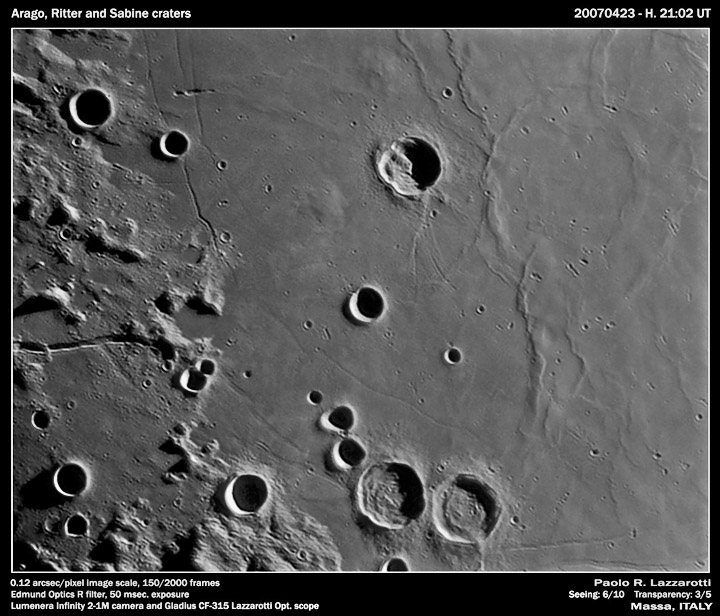
image by Paolo R. Lazzarotti, Massa, Italy.
The southwestern shore of Mare Tranquillitatis is one of the most diversely fascinating places on the Moon. And Paolo’s recent image gives new insights into the history of the area. The highlights are Arago with it central mountain that seems to reach the crater rim, the Arago domes (above and to the crater’s left), the concentric mare rings of Lamont, the untwins of Sabine and Ritter, the concentric rilles that mark where subsidence of the mare fractured its edges, and the short striations on the rough terrain to the west that were caused by the flow of Imbrium ejecta. I see some other things as well. To the west of Manners is a subtly rough roundish patch with the texture and hue of the Arago domes, but with a slightly larger diameter. Is this another large, but low relief, dome? Also notice the two Hypatia rilles in the lower right corner near the Apollo 11 landing site. Paolo’s image hints that the northern rille extends considerably further east than generally mapped. The diverenge in angle and morphology suggest that the two rilles may have formed in response to different forces. The southern rille is concentric to the basin edge implying that like most rilles here, it is a subsidence rille. The northern rille perhaps is not. Another intriguing rille is at the eastern end of the Ariadaeus Rille at the center left. A short fork of the rille bends south and is roughly concentric with the Tranquillitatis basin edge - was it also formed by the subsidence of the mare lavas? This is agreat image - keep looking to find other questions and maybe some answers!
Technical Details:
23 April 2007, 21:02 UT. Gladius CF-315 Lazzarotti telescope (f/25), Lumenera Infinity 2-1M camera, Edmund Optics R filter, 150 frames stack out of 2000. CAW applied Tony Gondola’s contrast mask technique to Paolo’s image. The original - and larger - image is here.
Related Links:
Rükl plate 35
Paolo’s website
The amazing telescope that creates these images
Yesterday's LPOD: Scooting Past
Tomorrow's LPOD: Get Out Your Red-Blue Glasses Again
COMMENTS?
Register, Log in, and join in the comments.



